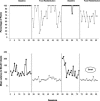Using food redistribution to reduce packing in children with severe food refusal
- PMID: 15898473
- PMCID: PMC1224408
- DOI: 10.1901/jaba.2005.168-03
Using food redistribution to reduce packing in children with severe food refusal
Abstract
Positive- and negative-reinforcement-based procedures typically have targeted acceptance for children with severe food refusal; however, these procedures do not always result in successful swallowing. Once acceptance is achieved, some children expel the food repeatedly or pack (hold or pocket) it in their mouths for extended periods of time. This study evaluated the effects of using food redistribution with a bristled massaging toothbrush to reduce packing and increase consumption in 4 children with severe feeding disorders. Packing was reduced for all children. In addition, latency to clean mouth (the duration of time from acceptance to food no longer being present in the child's mouth in the absence of expulsion) for 2 children decreased when the food-redistribution procedure was used. Results are discussed in terms of the potential operant functions of the food-redistribution procedure.
Figures
Similar articles
-
Analysis of response covariationamong multiple topographies of food refusal.J Appl Behav Anal. 2002 Spring;35(1):65-8. doi: 10.1901/jaba.2002.35-65. J Appl Behav Anal. 2002. PMID: 11936547 Free PMC article.
-
A comparison of Nuk presentation and Nuk redistribution to treat packing.J Appl Behav Anal. 2019 May;52(2):476-490. doi: 10.1002/jaba.532. Epub 2018 Dec 19. J Appl Behav Anal. 2019. PMID: 30569540
-
Using a flipped spoon to decrease packing in children with feeding disorders.J Appl Behav Anal. 2011 Fall;44(3):617-21. doi: 10.1901/jaba.2011.44-617. J Appl Behav Anal. 2011. PMID: 21941393 Free PMC article.
-
Antecedent interventions for pediatric feeding problems.J Appl Behav Anal. 2014 Summer;47(2):449-53. doi: 10.1002/jaba.117. Epub 2014 Apr 17. J Appl Behav Anal. 2014. PMID: 24740446 Review.
-
Synthesis of Applied Behavior Analytic Interventions for Packing in Pediatric Feeding Disorders.Behav Modif. 2018 Mar;42(2):249-272. doi: 10.1177/0145445517724541. Epub 2017 Aug 23. Behav Modif. 2018. PMID: 28831838 Review.
Cited by
-
Comparison of upright and flipped spoon presentations to guide treatment of food refusal.J Appl Behav Anal. 2012 Spring;45(1):83-96. doi: 10.1901/jaba.2012.45-83. J Appl Behav Anal. 2012. PMID: 22403451 Free PMC article.
-
Recent studies on feeding problems in children with autism.J Appl Behav Anal. 2010 Mar;43(1):155-9. doi: 10.1901/jaba.2010.43-155. J Appl Behav Anal. 2010. PMID: 20808508 Free PMC article. Review.
-
Brief Report: Packing Treatment Comparison and Use of a Chaser to Increase Swallowing for a Clinical Case.J Autism Dev Disord. 2022 Jul;52(7):3280-3285. doi: 10.1007/s10803-021-05176-5. Epub 2021 Jul 2. J Autism Dev Disord. 2022. PMID: 34213699
-
Evaluation of Empirical Pretreatment Assessments for Developing Treatments for Packing in Pediatric Feeding Disorders.Behav Anal Pract. 2019 Jul 8;13(1):137-151. doi: 10.1007/s40617-019-00372-3. eCollection 2020 Mar. Behav Anal Pract. 2019. PMID: 32231974 Free PMC article.
-
Assessing preferences of individuals with developmental disabilities: a survey of current practices.Behav Anal Pract. 2012 Winter;5(2):37-48. doi: 10.1007/BF03391822. Behav Anal Pract. 2012. PMID: 23730465 Free PMC article.
References
-
- Brown K.H, Black R.E, Lopez de Romana G, Creed de Kanashiro H. Infant feeding practices and their relationships with diarrhea and other diseases. Pediatrics. 1989;83:31–40. - PubMed
-
- Christophersen E.R, Hall C.L. Eating patterns and associated problems encountered in normal children. Issues in Comprehensive Pediatric Nursing. 1978;3:1–16. - PubMed
-
- Hoch T.A, Babbitt R.L, Coe D.A, Krell D.M, Hackbert L. Contingency contacting: Combining positive reinforcement and escape extinction procedures to treat persistent food refusal. Behavior Modification. 1994;18:106–128. - PubMed
Publication types
MeSH terms
Grants and funding
LinkOut - more resources
Full Text Sources




